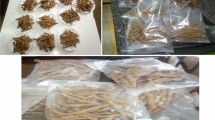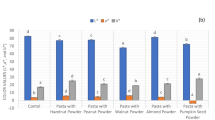Abstract
An optimization study on the use of oleoresin rosemary extract, sage extract, and citric acid added into refined, bleached, and deodorized (RBD) palm olein in deep-fat frying of potato chips was carried out using response surface methodology (RSM). Results showed that oleoresin rosemary extract was the most important factor affecting the sensory acceptability of potato chips. For taste and odor, its effects were highly significant (P<0.01), while for crispiness and overall acceptability, the effects were significant (P<0.05). As for sage extract, the level of this antioxidant had a highly significant (P<0.01) effect on appearance and taste and a significant effect (P<0.05) on odor and overall acceptability, but had no effect on crispiness. Although there was no significant synergistic correlation between citric acid and oleoresin rosemary extract or sage extract at the first order, its second order was significantly (P<0.05) related to taste, crispiness, and overall acceptability. An interaction between oleoresin rosemary and sage extracts also significantly (P<0.05) improved the score of overall acceptability of the potato chips. Contour maps of the sensory scores of potato chips indicated that the optimal points for appearance were achieved using 0.062% oleoresin rosemary extract, 0.066% sage extract, and 0.023% citric acid, while optimal task was achieved with 0.063% oleoresin rosemary extract, 0.075% sage extract, and 0.025% citric acid. With the same sequence of ingredients added into oil, the combinations required to achieve the optimal odor, crispiness, and overall acceptability scores were 0.058-0.046-0.026, 0.060-0.071-0.022, and 0.060-0.064-0.026%, respectively.
Similar content being viewed by others
References
Gwo, Y.Y., G.J. Flick Jr., and H.P. Dupuy, Effect of Ascorbyl Palmitate on the Quality of Frying Fats for Deep Frying Operations, J. Am. Oil Chem. Soc. 62:1666–1671 (1985).
Augustin, M.A., and S.K. Berry, Effectiveness of Antioxidants in Palm Olein During Heating and Frying, Ibid.:105–107 (1983).
Varela, O.M., B.R. Roso, and G. Varela, Effects of Frying on the Nutritive Value of Food, in Frying of Food: Principles, Changes, New Approach, edited by G. Varela, A.E. Bender, and I.D. Morton, Ellis Horwood Ltd., Chichester, 1988, pp. 93–102.
Asap, T., and M.A. Augustin, Effect of TBHQ on Quality Characteristics of RBD Palm Olein During Frying, J. Am. Oil Chem. Soc. 63:1169–1172 (1986).
Nawar, W.W., Saturation, Polyunsaturation and Lipid Oxidation, Nutrition Quarterly 14:38–42 (1990).
Lin, F.S, C.R. Warner, and T. Fazio, Alteration of Phenolic Antioxidants in Heated Vegetable Oil, J. Am. Oil Chem. Soc. July: 789–792 (1981).
Chang, S.S., B. Ostric-Matijasevic, O.A.L. Hsieh, and L.H. Cheng, Natural Antioxidants from Rosemary and Sage, J. Food Sci. 42:1102–1106 (1977).
Watanabe, Y., and Y. Ayano, Antioxidative Activities of Distillated Water-Soluble and Ethanol-Soluble Fractions from Spices, J. Japan Soc. Food Nutr. 27:181–183 (1974).
Saito, Y., Y. Kimura, and T. Sakamoto, Studies on the Antioxidant Properties of Spices, Ibid.:404–409 (1976).
Houlian, C. and C.T. Ho, Natural Antioxidant, in Flavour Chemistry of Fats and Oils, edited by D. Min and T. Smouse, American Oil Chemists’s Society, Champaign, 1985.
Chipault, J.R., G.R. Mizuno, and W.O. Lundberg, The Antioxidant Properties of Spices in Foods, Food Technol. 10:209–212 (1956).
Berner, D.L., and G.A. Jacobson, Spice Antioxidant Principle and Process for the Extraction Thereof, US Patent. 3,732,111 (1973).
Nakatani, N., Food Antioxidant Production from Sage, Japanese Patent 1-44232 (1989).
Che Man, Y.B., and J. Irwandi., Effect of Rosemary and Sage Extracts on Frying Performance of Refined, Bleached and Deodorized (RBD) Palm Olein During Deep-fat Frying, J. Sci. Food and Agric. No. 163/98 (under review) (1998).
Che Man, Y.B., and C.P. Tan, Effects of Natural and Synthetic Antioxidants on Changes in RBD Palm Olein During Deep-fat Frying of Potato Chips, J. Am. Oil Chem. Soc. No. 8855 (under review) (1998).
Wada, S., and X. Fang, Synergistic Antioxidants Effects of Rosemary and Tocopherol at Different Storage Temperatures and Its Application for Inhibiting Dried Sardine meta Oxidation, J. Japan oil Chem. Soc. 43:109–115 (1995).
Giovanny, M., Response Surface Methodology and Product Optimization, Food Technol. Nov.:41–45, 83 (1983).
Henika, R.G., Use of Response Surface Methodology in Sensory Evaluation, Food Technol. Nov:96–101 (1982).
Wheeler, B., Echip-Version 6.0 for Windows. Reference Manual, Echip Inc., Hockessin, Delaware (1993).
Larmond, E. Laboratory Methods for Sensory Evaluation of Food, Publication 1637, Food Research Institute, Ottawa, Canada (1977).
Official and Tentative Methods of The American Oil Chemists’ Society, 3rd edn., AOCS, Champaign, (1974).
Standard Methods for The Analysis of Oils, Fats and Derivatives, 6th edn., International Union of Pure and Applied Chemistry, Pergamon Press Ltd., Oxford, (1979).
Berry, S.K., Cyclopropene Fatty Acids in Some Malaysian Edible Seeds and Nuts: I. Durian (Durio zibethinus, Murr), Lipids 15:452–455 (1980).
Augustin, M.A., L.K. Heng, and N.A. Idris, Evaluation of Potato Crisps in Market Samples of Palm Olein, Corn Oil and Soya Oil, Pertanika 11:399–406 (1988).
Chong, S., J. Robert, R.J. Peterson and C.T. Ho, Chemical Reactions Involved in the Deep-Fat Frying of Foods, J. Am. Oil Chem. Soc. 55:718–727 (1978).
Che Man, Y.B., and W.R. Hussin, Comparison of Frying Performance of Refined, Bleached and Deodorized Palm Olein and Coconut Oil, J. Food Lipids. (1998).
Idris, N.A., A. Abdullah, and A.H. Halim, Evaluation of Palm Oil Quality: Correlating Sensory with Chemical Analyses, J. Am. Oil Chem. Soc. 69:272–275 (1992).
Author information
Authors and Affiliations
Corresponding author
About this article
Cite this article
Jaswir, I., Che Man, Y.B. Use optimization of natural antioxidants in refined, bleached, and deodorized palm olein during repeated deep-fat frying using response surface methodology. J Amer Oil Chem Soc 76, 341–348 (1999). https://doi.org/10.1007/s11746-999-0241-x
Received:
Accepted:
Issue Date:
DOI: https://doi.org/10.1007/s11746-999-0241-x




